Energy 3,607 kJ (862 kcal) Saturated 86.5 Polyunsaturated 1.8 | Fat 100 Monounsaturated 5.8 Vitamin E (1%)0.09 mg | |
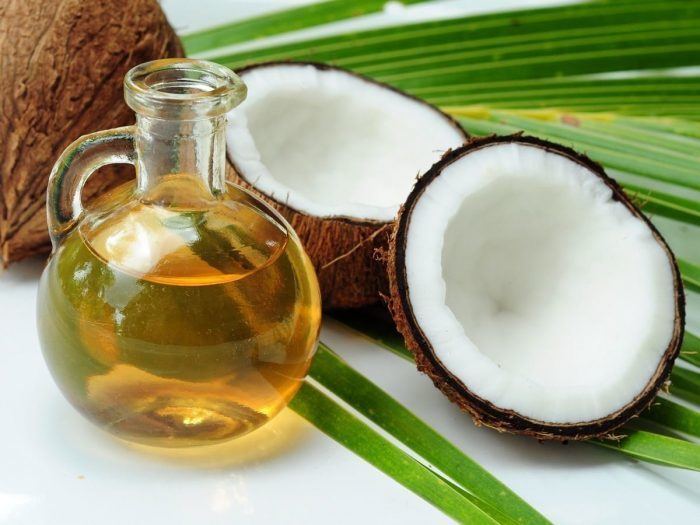 | ||
Similar Coconut, Palm oil, Butter, Shea butter, Coconut milk | ||
Coconut oil 101
Coconut oil, or copra oil, is an edible oil extracted from the kernel or meat of mature coconuts harvested from the coconut palm (Cocos nucifera). It has various applications. Because of its high saturated fat content, it is slow to oxidize and, thus, resistant to rancidification, lasting up to six months at 24 °C (75 °F) without spoiling.
Contents
- Coconut oil 101
- How to make coconut oil in your home
- Dry process
- Wet process
- Refined oil
- Hydrogenation
- Fractionation
- Figures
- Standards
- Composition and comparison
- Health concerns
- In food
- Industry
- References

Due to its high levels of saturated fat, the World Health Organization, United States Food and Drug Administration, International College of Nutrition, the United States Department of Health and Human Services, American Dietetic Association, American Heart Association, British National Health Service, British Nutrition Foundation and Dietitians of Canada advise against regular consumption of coconut oil.
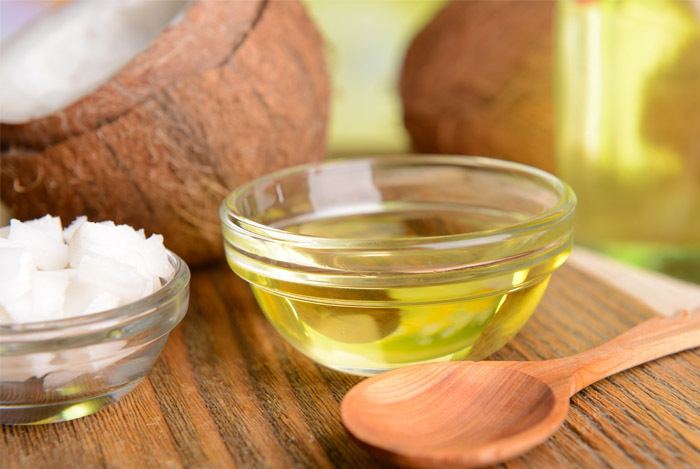
How to make coconut oil in your home
Dry process
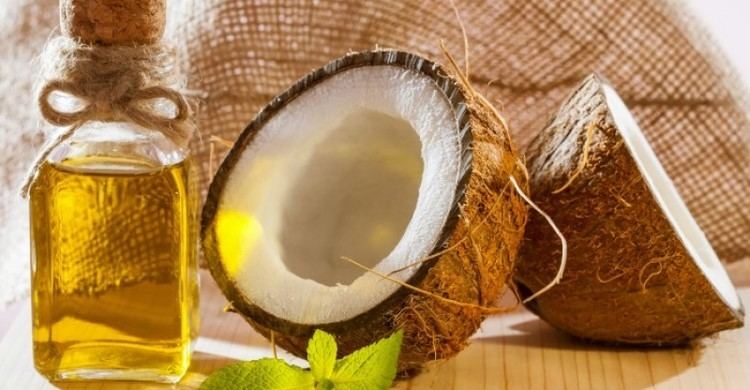
Coconut oil can be extracted through "dry" or "wet" processing. Dry processing requires that the meat be extracted from the shell and dried using fire, sunlight, or kilns to create copra. The copra is pressed or dissolved with solvents, producing the coconut oil and a high-protein, high-fiber mash. The mash is of poor quality for human consumption and is instead fed to ruminants; there is no process to extract protein from the mash.
Wet process

The all-wet process uses raw coconut rather than dried copra, and the protein in the coconut creates an emulsion of oil and water. The more problematic step is breaking up the emulsion to recover the oil. This used to be done by prolonged boiling, but this produces a discolored oil and is not economical. Modern techniques use centrifuges and pre-treatments including cold, heat, acids, salts, enzymes, electrolysis, shock waves, steam distillation, or some combination. Despite numerous variations and technologies, wet processing is less viable than dry processing due to a 10–15% lower yield, even taking into account the losses due to spoilage and pests with dry processing. Wet processes also require investment of equipment and energy, incurring high capital and operating costs.

Proper harvesting of the coconut (the age of a coconut can be 2 to 20 months when picked) makes a significant difference in the efficacy of the oil-making process. Copra made from immature nuts is more difficult to work with and produces an inferior product with lower yields.
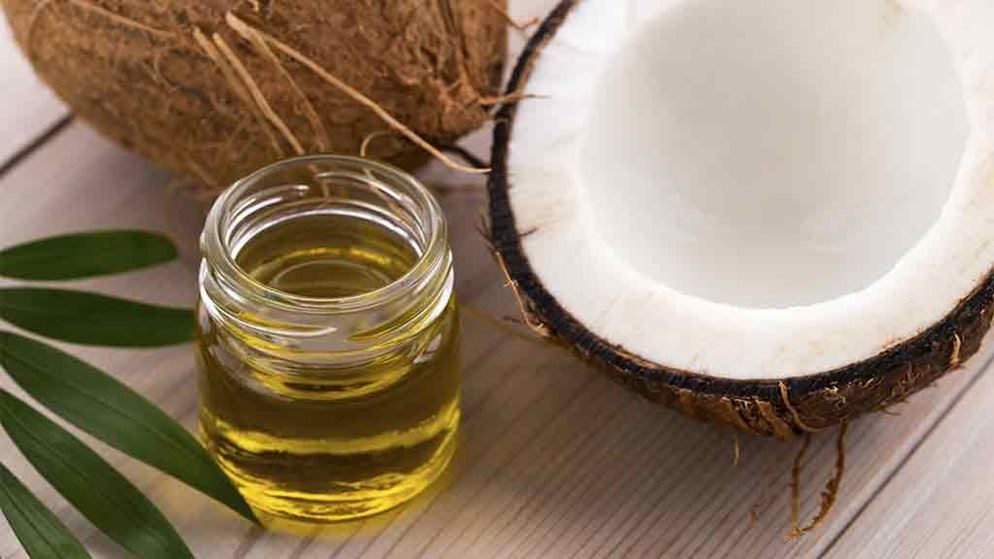
Conventional coconut oil processors use hexane as a solvent to extract up to 10% more oil than produced with just rotary mills and expellers. They then refine the oil to remove certain free fatty acids to reduce susceptibility to rancidification. Other processes to increase shelf life include using copra with a moisture content below 6%, keeping the moisture content of the oil below 0.2%, heating the oil to 130–150 °C (266–302 °F) and adding salt or citric acid.
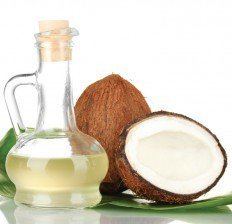
Virgin coconut oil (VCO) can be produced from fresh coconut milk, meat, or residue. Producing it from the fresh meat involves either wet-milling or drying the residue, and using a screw press to extract the oil. VCO can also be extracted from fresh meat by grating and drying it to a moisture content of 10–12%, then using a manual press to extract the oil. Producing it from coconut milk involves grating the coconut and mixing it with water, then squeezing out the oil. The milk can also be fermented for 36–48 hours, the oil removed, and the cream heated to remove any remaining oil. A third option involves using a centrifuge to separate the oil from the other liquids. Coconut oil can also be extracted from the dry residue left over from the production of coconut milk.
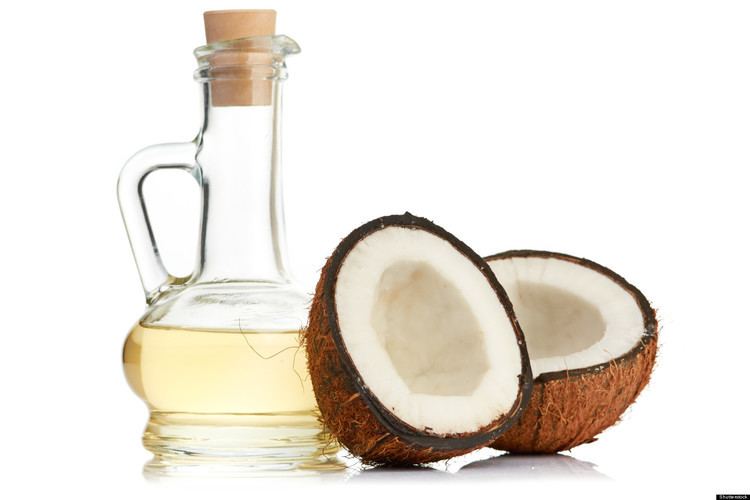
A thousand mature coconuts weighing approximately 1,440 kilograms (3,170 lb) yield around 170 kilograms (370 lb) of copra from which around 70 litres (15 imp gal) of coconut oil can be extracted.
Refined oil
"Refined, bleached, and deodorized" (RBD) oil is usually made from copra, dried coconut kernel, which is pressed in a heated hydraulic press to extract the oil. This yields practically all the oil present, amounting to more than 60% of the dry weight of the coconut. This "crude" coconut oil is not suitable for consumption because it contains contaminants and must be refined with further heating and filtering.
Another method for extraction of coconut oil involves the enzymatic action of alpha-amylase, polygalacturonases, and proteases on diluted coconut paste.
Unlike virgin coconut oil, refined coconut oil has no coconut taste or aroma. RBD oil is used for home cooking, commercial food processing, and cosmetic, industrial, and pharmaceutical purposes.
Hydrogenation
RBD coconut oil can be processed further into partially or fully hydrogenated oil to increase its melting point. Since virgin and RBD coconut oils melt at 24 °C (76 °F), foods containing coconut oil tend to melt in warm climates. A higher melting point is desirable in these warm climates, so the oil is hydrogenated. The melting point of hydrogenated coconut oil is 36–40 °C (97–104 °F).
In the process of hydrogenation, unsaturated fats (monounsaturated and polyunsaturated fatty acids) are combined with hydrogen in a catalytic process to make them more saturated. Coconut oil contains only 6% monounsaturated and 2% polyunsaturated fatty acids. In the partial hydrogenation process, some of these are transformed into trans fatty acids.
Fractionation
Fractionated coconut oil provides fractions of the whole oil so that its different fatty acids can be separated for specific uses. Lauric acid, a 12-carbon chain fatty acid, is often removed because of its high value for industrial and medical purposes. The fractionation of coconut oil can also be used to isolate caprylic acid and capric acid, which are medium-chain triglycerides, as these are used for medical applications, special diets and cosmetics, sometimes also being used as a carrier oil for fragrances.
Figures
The United States Department of Agriculture has published estimated production figures for coconut oil as follows; tabulated years are from October 1 through September 30:
Coconut oil makes up around 2.5% of world vegetable oil production.
Standards
The World Health Organization's Codex Alimentarius guidelines on food, food production, and food safety, published by the Food and Agriculture Organization, includes standards for commercial partners who produce coconut oil for human consumption.
The Asian and Pacific Coconut Community (APCC), whose 18 members produce about 90 per cent of the coconut sold commercially, has published its standards for virgin coconut oil (VCO), defining virgin coconut oil as obtained from fresh, mature coconut kernels through means that do not "lead to alteration of the oil."
Composition and comparison
The approximate concentration of fatty acids in coconut oil (midpoint of range in source):
The following table provides information about the composition of coconut oil and how it compares with other vegetable oils.
Health concerns
Many health organizations advise against the consumption of coconut oil due to its high levels of saturated fat, including the United States Food and Drug Administration, World Health Organization, International College of Nutrition, the United States Department of Health and Human Services, American Dietetic Association, American Heart Association, British National Health Service, British Nutrition Foundation and Dietitians of Canada.
Coconut oil contains a large proportion of lauric acid, a saturated fat that raises total blood cholesterol levels by increasing both the amount of high-density lipoprotein (HDL) cholesterol and low-density lipoprotein (LDL) cholesterol. Although this may create a more favorable total blood cholesterol profile, this does not exclude the possibility that persistent consumption of coconut oil may increase the risk of cardiovascular disease through other mechanisms, particularly via the marked increase of blood cholesterol induced by lauric acid. Because the majority of saturated fat in coconut oil is lauric acid, coconut oil may be preferred over partially hydrogenated vegetable oil when solid fats are used in the diet.
Due to its high content of saturated fat with corresponding high caloric burden, regular use of coconut oil in food preparation may promote weight gain.
In food
Coconut oil is commonly used in cooking, especially for frying, and is a common flavor in many South Asian curries. In recent years despite its high saturated fat content, virgin coconut oil has become popular and was described in a New York Times article as having a "haunting, nutty", flavor with a touch of sweetness, which works well in baked goods, pastries, and sautés. Used by movie theatre chains to pop popcorn, coconut oil adds considerable saturated fat and calories to the snackfood, possibly leading to an increase in energy balance and weight gain.
Other culinary uses include replacing solid fats produced through hydrogenation in baked and confectionery goods. Hydrogenated or partially hydrogenated coconut oil is often used in non-dairy creamers and snack foods, including popcorn.
The smoke point of coconut oil is 177 °C (351 °F).
Industry
Coconut oil has been tested for use as a feedstock for biodiesel to use as a diesel engine fuel. In this manner, it can be applied to power generators and transport using diesel engines. Since straight coconut oil has a high gelling temperature (22–25 °C), a high viscosity, and a minimum combustion chamber temperature of 500 °C (932 °F) (to avoid polymerization of the fuel), coconut oil typically is transesterified to make biodiesel. Use of B100 (100% biodiesel) is possible only in temperate climates, as the gel point is approximately 10 °C (50 °F). The oil must meet the Weihenstephan standard to use pure vegetable oil as a fuel. Moderate to severe damage from carbonisation and clogging would occur in an unmodified engine.
The Philippines, Vanuatu, Samoa, and several other tropical island countries use coconut oil as an alternative fuel source to run automobiles, trucks, and buses, and to power generators. Coconut oil is currently used as a fuel for transport in the Philippines. Further research into the potential of coconut oil as a fuel for electricity generation is being carried out in the islands of the Pacific, although to date it appears that it is not useful as a fuel source due to the cost of labour and supply constraints.
Coconut oil has been tested for use as an engine lubricant and as a transformer oil.
Acids derived from coconut oil can be used as herbicides.
Coconut oil (and derivatives, such as coconut fatty acid) are used as raw materials in the manufacture of surfactants such as cocamidopropyl betaine, cocamide MEA, and cocamide DEA.
Before the advent of electrical lighting, coconut oil was the primary oil used for illumination in India and was exported as cochin oil.
Coconut oil is an important base ingredient for the manufacture of soap. Soap made with coconut oil tends to be hard, though it retains more water than soap made with other oils and therefore increases manufacturer yields. It is more soluble in hard water and salt water than other soaps allowing it to lather more easily. A basic coconut oil soap is clear when melted and a bright white when hardened.
